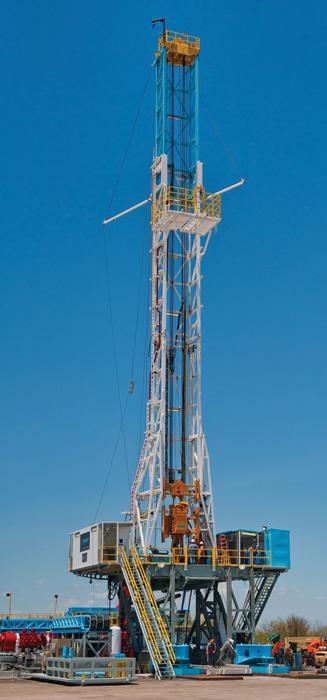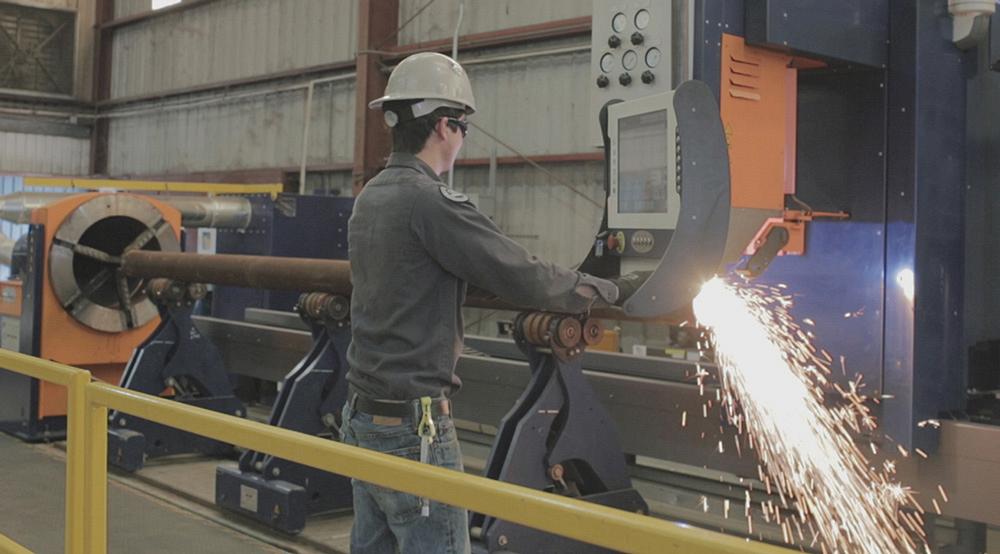- FMA
- The Fabricator
- FABTECH
- Canadian Metalworking
Categories
- Additive Manufacturing
- Aluminum Welding
- Arc Welding
- Assembly and Joining
- Automation and Robotics
- Bending and Forming
- Consumables
- Cutting and Weld Prep
- Electric Vehicles
- En Español
- Finishing
- Hydroforming
- Laser Cutting
- Laser Welding
- Machining
- Manufacturing Software
- Materials Handling
- Metals/Materials
- Oxyfuel Cutting
- Plasma Cutting
- Power Tools
- Punching and Other Holemaking
- Roll Forming
- Safety
- Sawing
- Shearing
- Shop Management
- Testing and Measuring
- Tube and Pipe Fabrication
- Tube and Pipe Production
- Waterjet Cutting
Industry Directory
Webcasts
Podcasts
FAB 40
Advertise
Subscribe
Account Login
Search
Orion Drilling Co. has rigs, will travel
Walking-rig builder uses CNC plasma/oxyfuel machine for improved accuracy, productivity
- By Eric Lundin
- July 16, 2015
- Article
- Tube and Pipe Fabrication
Although petroleum prices have gone through some severe price swings in the last few years—for example, the spot price for West Texas Intermediate fell by half from June to December 2014—Orion® Drilling Co., Corpus Christi, Texas, remains busy. A fabricator of drilling rigs, it runs two shifts a day, six days a week.
Orion’s rigs are not only specially designed for land-based oil and gas drilling, but each rig must have a compact, collapsible design; must be constructed from high-strength, lightweight steel; and must be capable of highway travel for destinations as far away as Pennsylvania. Then, when the rigs get to those final destinations, they must be extendible. Masts telescope up to 300 ft.
The company also is known for being the developer of the first southern Texas walking rig. This type of substructure, a design that can literally walk across land-based obstacles, requires a structurally sound, lightweight design with extremely tight connection tolerances. Each rig requires several hundred individual parts and sections of round and square tube and pipe mated in a variety of angles. Weld draw, the metal gap that welders encounter during fit-up, must be minimal to facilitate welding and reduce welding time, to improve overall accuracy and quality, and to maximize Orion’s productivity.
Accuracy Is Key
Before purchasing a 3-D pipe cutting machine, Orion subcontracted as much as 25 percent of its work to fabricators throughout Texas, commissioning those with robotic machines that specialized in cutting pipes and I-beams. Unfortunately, the cut quality was rarely up to Orion’s requirements.
“Maintaining a tight tolerance was a constant issue and problem,” said Drilling Production Manager Ram Cortez. “For us, the final straw was a situation where we had to disassemble an entire rig and scrap it because the quality was simply not there.”
Just a week before purchasing a pipe cutting machine to bring this work in-house, an Orion manager received a call from a salesman from HGG Profiling Equipment. HGG presented Orion with a customized alternative, a 3-D profiling machine capable of quick, easy configuration changes to cut round, square, or rectangular tube and pipe as well as flat plate. Along with enabling Orion to cut using either plasma or oxyfuel, the Multi-profile Cutting Machine (MPC) would consistently perform cuts with a tolerance of less than 2 mm, essentially eliminating weld draw (see Figure 1).
With respect to software, the machine would give Orion the flexibility to read several cutting programs such as Inventor® and would convert STEP files from its 3-D CAD systems. It also would allow the company’s machine operators to program parts right at the machine, change part programs on-the-fly, and download part drawings from offline part programming centers, which accounts for the majority of their cutting operation.
Gauging Productivity. After a two-week installation and a weeklong training session, Orion machine operators—even those without CNC experience—were running the machine proficiently.
Since the installation, productivity improvements have been dramatic, according to the company. To begin with, Cortez said that the machine does the work of about eight people. Before buying the machine, Orion paid as many as eight welders 10 hours a day, six days a week to cut squares and rounds. They also had to outsource as much as 25 percent of their fabrication work, which translated into a $250,000 cost. Now one machine operator does the work of all eight welders, and Orion no longer needs to outsource pipe cutting or rig fabrication. Plus, instead of also being responsible for cutting tube and pipe parts, Orion welders now do fit-up and welding only, which is a better use of their time. The machine allowed the company to bring its plate cutting operations in-house, too, giving it more control over lead times and quality.
Cortez estimate that their production flow has improved by a minimum of 20 percent.

Figure 1
Orion’s MPC machine has a cutting tolerance of 2 mm, which has essentially eliminated
the gaps welders must fill when assembling a rig.
“More important, we can now start cutting early and stage it,” he said. “We are also routinely creating as much as two weeks of backlog for our welders and fitters.”
Return on Investment. Orion uses the machine to cut during two shifts a day, six days a week. Cortez figures the machine is operational about 60 to 70 percent of the time. Orion uses the machine for precision plasma cutting of material thicknesses from ½ to 1 in. about 90 percent of that time (see Figure 2). It uses the oxyfuel capability about 10 percent of the time and to cut thicknesses greater than 11⁄2 in. Changing from one to the other process is almost seamless.
All of this adds up to a short ROI period.
“The machine should pay for itself with our first three rigs and within the first year,” Cortez said. “Just as important, the MPC machine has put an end to outsourcing,” reducing the company’s lead times.
Cortez said, “Just recently a rig went down and we needed to respond in a hurry. Within six weeks we already had two-thirds of the new rig rebuilt. We could have never done that before. It would have taken us months.”
Safer With Less Handling. Before purchasing the machine, Orion cut parts at various workstations throughout the shop.
“With the machine now in one place, we have improved and automated our production flow, creating an assembly line of sorts.” With respect to plant safety, this means that one area of the production floor is now dedicated to cutting parts. This has minimized material handling, greatly reducing the need to move parts from one location to another on the shop floor. This, in turn, greatly reduces the potential for accidents.
Next for Orion
This installation wasn’t the end of the line. When asked about the future,
Cortez said, “When HGG installed the machine, we instructed them to build and position the machine so that it could be moved or modified easily. We already have plans to add on to the machine footprint in the near future, expanding our automated production capability.”
About the Author

Eric Lundin
2135 Point Blvd
Elgin, IL 60123
815-227-8262
Eric Lundin worked on The Tube & Pipe Journal from 2000 to 2022.
About the Publication
Related Companies
subscribe now

The Tube and Pipe Journal became the first magazine dedicated to serving the metal tube and pipe industry in 1990. Today, it remains the only North American publication devoted to this industry, and it has become the most trusted source of information for tube and pipe professionals.
start your free subscription- Stay connected from anywhere

Easily access valuable industry resources now with full access to the digital edition of The Fabricator.

Easily access valuable industry resources now with full access to the digital edition of The Welder.

Easily access valuable industry resources now with full access to the digital edition of The Tube and Pipe Journal.
- Podcasting
- Podcast:
- The Fabricator Podcast
- Published:
- 04/16/2024
- Running Time:
- 63:29
In this episode of The Fabricator Podcast, Caleb Chamberlain, co-founder and CEO of OSH Cut, discusses his company’s...
- Industry Events
16th Annual Safety Conference
- April 30 - May 1, 2024
- Elgin,
Pipe and Tube Conference
- May 21 - 22, 2024
- Omaha, NE
World-Class Roll Forming Workshop
- June 5 - 6, 2024
- Louisville, KY
Advanced Laser Application Workshop
- June 25 - 27, 2024
- Novi, MI

































